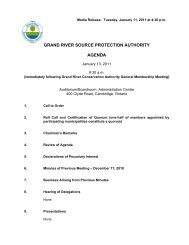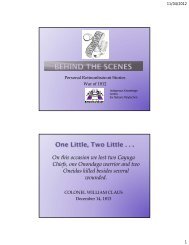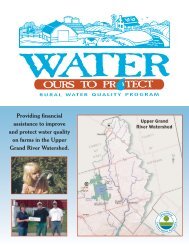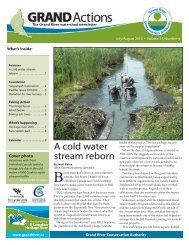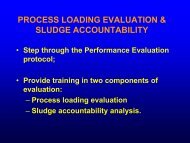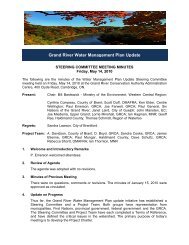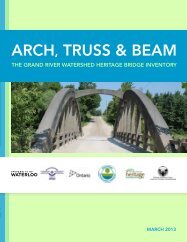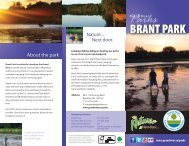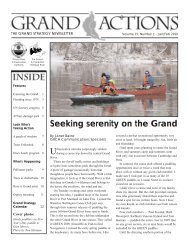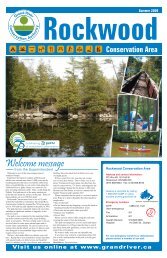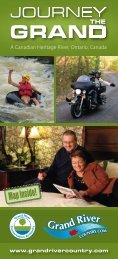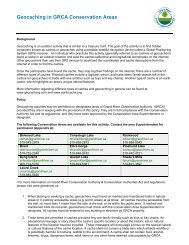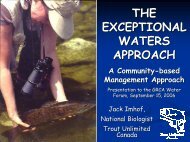Warren Yerex - Grand River Conservation Authority
Warren Yerex - Grand River Conservation Authority
Warren Yerex - Grand River Conservation Authority
Create successful ePaper yourself
Turn your PDF publications into a flip-book with our unique Google optimized e-Paper software.
9 Th Annual <strong>Grand</strong> <strong>River</strong> Watershed Water Forum<br />
Ecology
9 Th Annual <strong>Grand</strong> <strong>River</strong> Watershed Water Forum<br />
Outline<br />
• The Lake Erie Environment<br />
• The Lake / <strong>River</strong> Interface<br />
• Fisheries Management in the <strong>River</strong> and the<br />
Lake : Acknowledging the Connection<br />
• Beyond Fish: Describing the Ecosystem<br />
• Documenting Ecosystem Dysfunction<br />
• Moving toward Rehabilitation
Looking Upstream
The Lake Erie Watershed<br />
ON<br />
GR<br />
MI<br />
NY<br />
Lake Erie<br />
PA<br />
OH
The Lake Environment<br />
West Central East
9 Th Annual <strong>Grand</strong> <strong>River</strong> Watershed Water Forum<br />
The <strong>River</strong> / Lake Interface
<strong>River</strong>/Lake:<br />
Nutrients and Productivity<br />
• Eutrophic (high<br />
nutrient) <strong>River</strong> Water<br />
meets Oligotrophic (low<br />
nutrient) Lake Water<br />
• High primary<br />
production (planktonic<br />
algae) meets Low<br />
primary production<br />
TP (ug / L)<br />
Chlorophyl (ug / L)<br />
160<br />
140<br />
120<br />
100<br />
80<br />
60<br />
40<br />
20<br />
70<br />
60<br />
50<br />
40<br />
30<br />
20<br />
10<br />
0<br />
*<br />
01/May 01/Jun 01/Jul 01/Aug 01/Sep 01/Oct 01/Nov<br />
L.E. eastern basin nearshore<br />
<strong>Grand</strong> <strong>River</strong> at Dunnville<br />
2004<br />
L.E. eastern basin nearshore<br />
<strong>Grand</strong> <strong>River</strong> at Dunnville<br />
0<br />
01/May 01/Jun 01/Jul 01/Aug 01/Sep 01/Oct 01/Nov<br />
2004
Dunnville<br />
3<br />
2<br />
<strong>River</strong> Water<br />
higher conductivity<br />
1<br />
0 825 1,650<br />
412.5 Meters<br />
3.5 m depth<br />
Lake Water<br />
lower conductivity<br />
4.5 m depth<br />
Stn 3:<br />
5 km upstream<br />
Schematic:<br />
with conductivity data from June 15, 2005<br />
Stn 2:<br />
3.5 km upstream<br />
6 m depth<br />
Stn 1:<br />
2 km upstream
<strong>River</strong> / Lake: Water Levels<br />
177<br />
ABOVE DAM<br />
BELOW DAM<br />
Upstream of Lake Effect Zone<br />
<strong>River</strong> elevation (m)<br />
176<br />
175<br />
Lake Effect Zone<br />
174<br />
May Jun Jul Aug Sep Oct<br />
Date (2004)
Lake / <strong>River</strong> / Lake Conceptual Model
Lake / <strong>River</strong> / Lake Conceptual Model
<strong>Grand</strong> <strong>River</strong> Fisheries Management Plan<br />
• Desired Fish Community for the Lower <strong>River</strong><br />
Reach:<br />
– diverse warmwater fish community dominated by<br />
top predators<br />
– e.g., walleye, muskellunge, pike, channel catfish<br />
• Inclusive input<br />
• 1998
Lake Erie Fish Community<br />
Goals and Objectives<br />
• Great Lakes Fishery Commission - Lake Erie<br />
Committee<br />
• To secure a balanced, predominantly<br />
cool-water fish community with WALLEYE<br />
as a key predator in…<br />
• the near-shore waters of the eastern<br />
basin, characterized by self-sustaining<br />
indigenous and naturalized species that<br />
occupy diverse habitats, provide valuable<br />
fisheries, and reflect a healthy ecosystem<br />
P.A., R. Knight, R. MacGregor, G. Towns, R. Hoopes, and W.<br />
Culligan. 2003. Fish-community goals and objectives for Lake<br />
Erie. Great Lakes Fish. Comm. Spec. Publ. 03-02. 56 p.
Fish Community Objectives<br />
1. Ecosystem conditions<br />
2. Productivity and yield<br />
3. Nearshore habitat<br />
4. <strong>River</strong>ine and estuarine habitat -Protect and restore self-sustaining,<br />
stream-spawning stocks of walleye, white bass, (lake sturgeon), and<br />
rainbow trout.<br />
5. Western basin<br />
6. Central basin<br />
7. Eastern basin<br />
8. Contaminants<br />
9. Fish habitat<br />
10. Genetic diversity -Maintain and promote genetic diversity by<br />
identifying, rehabilitating, conserving and/or protecting locally adapted<br />
stocks.<br />
11. Rare, threatened, and endangered species<br />
12. Forage fish<br />
13. Food web structure
Environmental Objectives<br />
Environmental<br />
Structures, Processes<br />
or Conditions that<br />
must be addressed at<br />
a number of spatial<br />
scales to effect<br />
achievement of the<br />
FCGOs
Lake Erie Environmental Objectives<br />
• Fish Access<br />
– Improve access to spawning and nursery habitat in rivers and coastal<br />
wetlands for native and naturalized fish species<br />
• <strong>River</strong>s and Estuaries<br />
– Restore natural hydrological functions in Lake Erie rivers and<br />
estuaries<br />
• Coastal Wetlands and Submerged Macrophytes<br />
– Restore submerged macrophyte communities in estuaries and<br />
embayments and protected nearshore areas<br />
• Dissolved Oxygen<br />
– Maintain dissolved oxygen conditions necessary to complete all life<br />
history stages of fishes and aquatic invertebrates<br />
• Coastal and Shoreline Processes<br />
– Restore natural coastal systems and nearshore hydrological<br />
processes
Hydrologic issues<br />
Low flows<br />
(climate, water taking/reservoir discharge)<br />
Increased retention times (dams)<br />
-reduced water<br />
column mixing<br />
-thermal structure<br />
with depth<br />
Periods<br />
of low<br />
oxygen<br />
High nutrients<br />
(point and non-point inputs of<br />
phosphorus/nitrogen)<br />
High sediment<br />
load<br />
(erosion / disturbed<br />
clay landscape)<br />
Total<br />
suspended<br />
solids<br />
Loading and Eroding Issues<br />
reduced<br />
PAR at<br />
depth<br />
Planktonic<br />
algae<br />
(abundant)<br />
macrophytes (low)<br />
Deposition<br />
areas<br />
Zooplankton<br />
(large grazers absent)<br />
reduced<br />
habitat<br />
structure<br />
Substrate disturbing, plant<br />
uprooting, generalist fish<br />
species<br />
Benthic invertebrates<br />
(low diversity, pollution tolerant<br />
individuals)<br />
Freshwater<br />
Mussels<br />
(impacted?)<br />
Fish Community<br />
(low diversity, pollution<br />
tolerant individuals)<br />
Habitat<br />
Fragmentation<br />
Issues<br />
-reset of dynamic gradient (RCC)<br />
-Upstream areas separated from water<br />
level variation associated lake levels
Southern <strong>Grand</strong> <strong>River</strong> Ecosystem<br />
Working Group<br />
• Federal Agencies<br />
– Environment Canada<br />
– Dept. Fisheries and Oceans<br />
• First Nations<br />
– Six Nations Eco-centre<br />
• Provincial Agencies<br />
– Ministry of Natural Resources<br />
– Ministry of the Environment<br />
• Local / Watershed Agencies<br />
– <strong>Grand</strong> <strong>River</strong> <strong>Conservation</strong><br />
<strong>Authority</strong><br />
– Stewardship Councils
Small Scale / Incremental<br />
• Small but ongoing<br />
• Incremental OR<br />
temporary stop-gap<br />
• Relatively cheap<br />
Walleye transfer at Dunnville<br />
• Local community engaged<br />
• Long time to realize<br />
improvement<br />
Cattle fencing near Wellesley
Examples<br />
• Taquanyah reservoir<br />
draw down<br />
• Pike Creek reconnection<br />
• Higher Costs<br />
• More planning and<br />
stakeholder investment<br />
• Long term benefits<br />
realized more quickly<br />
Medium Scale
Large Scale<br />
• Examples<br />
– WPCP upgrades (WQ)<br />
– Coastal wetlands (habitat)<br />
– Dunnville Dam retrofit or<br />
removal (full or partial)<br />
• Expensive and Complex<br />
• Considerable negotiation and<br />
buy-in<br />
• More objectives realized<br />
quickly
• Fish Access<br />
Large Scale Projects<br />
Multiple Environmental Objectives<br />
– Improve access to spawning and nursery habitat in rivers and coastal<br />
wetlands for native and naturalized fish species<br />
• <strong>River</strong>s and Estuaries<br />
– Restore natural hydrological functions in Lake Erie rivers and estuaries<br />
• Coastal Wetlands and Submerged Macrophytes<br />
– Restore submerged macrophyte communities in estuaries and<br />
embayments and protected nearshore areas<br />
• Dissolved Oxygen<br />
– Maintain dissolved oxygen conditions necessary to complete all life history<br />
stages of fishes and aquatic invertebrates<br />
• Coastal and Shoreline Processes<br />
– Restore natural coastal systems and nearshore hydrological processes
Remember: work in the watershed has<br />
lakewide implications
<strong>Grand</strong> <strong>River</strong> is on the radar bi-nationally<br />
• Ecosystem Objectives – Rehabilitating the<br />
<strong>Grand</strong> <strong>River</strong> is a bi-national Priority for<br />
fisheries objectives for Lake Erie<br />
• Recent invited presentations<br />
– International Joint Commission: Great Lakes Urban Habitat<br />
Restoration Symposium, Chicago, January 2009<br />
– Great Lakes Fishery Commission: Lake Erie Committee<br />
State of the Lake, Ypsilanti, Michigan, March, 2009
We recognize that the river lake interface is best described as a<br />
complex and dynamic niche BUT we know more about the<br />
ecology of this system than ever before.<br />
The importance of this ecosystem is recognized at scales that<br />
range from local to bi-national.<br />
We know what needs to be fixed and have several ways of<br />
moving forward.<br />
It will take a combination of small incremental steps and large<br />
leaps forward.<br />
The time it takes to realize our goals and objectives will depend<br />
upon our ability and conviction to tackle the large components.
Credits<br />
• Tom MacDougall, Rehabilitation Ecologist, Great Lakes<br />
Branch, Ministry of Natural Resources<br />
• Fieldwork: OFAH Clubs (Dunnville District Hunters and<br />
Anglers, Port Colborne <strong>Conservation</strong> Club, Fort Erie<br />
<strong>Conservation</strong> Club); Lori Richardson, Kari Killins, Daryl<br />
Davis and Janice Gilbert<br />
• Phil Ryan (retired from MNR)<br />
• Sandra George, Environment Canada<br />
• Larry Halyk, Ministry of Natural Resources<br />
• Felix Barbetti (photos)<br />
• Anne Loeffler, GRCA
9 Th Annual <strong>Grand</strong> <strong>River</strong> Watershed Water Forum<br />
Key Messages
Steps To a Healthy Watershed & Great Lake –<br />
Rebuilding the Link<br />
• There are strong connections between the<br />
<strong>Grand</strong> <strong>River</strong> and Lake Erie – the health of Lake<br />
Erie is influenced by the health of the river<br />
• An ecosystem approach is needed – if we fix<br />
the land, we fix the river.. and if we fix the<br />
river, we fix the lake!<br />
• Collaboration and partnerships are key – we<br />
need a shared vision, pooling of resources and<br />
commitment to targeted upstream action
Steps To a Healthy<br />
Watershed & Great Lake<br />
– Rebuilding the Link<br />
• Actions need to<br />
be informed by<br />
a shared vision,<br />
relevant data<br />
and science to<br />
be effective.<br />
• Actions need to<br />
be taken now.



